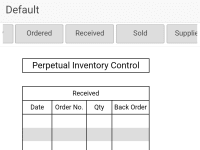The refurbishment of rotable components is important for aerospace companies, for which system availability is a critical factor, and for which rotables guarantee a high level of system availability. The refurbishment of usually high value faulty rotables is of considerable economic importance for companies, and is often a core process in plant maintenance. It is often much more cost-effective than a brand new purchase.
In aircraft or other technical objects such as engines, high value components are often used (such as landing gear) which, in a Remove-Install-Rework scenario, are replaced in cases of damage by a serviceable rotable and then refurbished at a later point in time using a separate order. In addition to the functions for Plant Maintenance, functions from Production, Inventory Management, and Materials Planning are also used for the refurbishment of rotables.
Our software solution enables rotables inventory management. It helps you keep track of the inventory information such as item name, total units, unit price and total value of the items. Space is provided for notes too. Locally save the inventory information as a file, and re-use it with minimal changes. Simply tap e-mail to share your files. Alternatively, you can email the file to yourself. A seamless app catering to your inventory management needs.
Further, our software solution enables you to keep track of where to keep your repair documents and for how long to keep them. Simply enter the document name, where to keep the document and for how long to keep it. We have added simple sharing capabilities like email and print for all the sheets to help you make the efforts a collaborative endeavor.
We are also using Ethercalc (https://ethercalc.net/) for computation, collaboration and sharing of spreadsheet. EtherCalc is the spreadsheet equivalent of a wiki document, without logins and without editing locks. People can collaborate on a spreadsheet-like page simultaneously. It's somewhat a google sheet alternative, open source style.
Rotable Management Process
1. Procurement of new rotables - For certain critical and high-value components used in a technical system, we procure new rotable components to replace components promptly in the case of a breakdown.
We procure new rotables using Materials Management. We order the components, which are delivered to the serviceable stock warehouse, such as a central warehouse. We create a material or equipment master record for the rotable. If desired, the rotable can be serialized as an individual piece of material for the goods issue in the planned storage location, assigned to a batch, and valuated.
2. Exchange of unserviceable and serviceable rotables
3. Creation of the refurbishment order
4. Release and execution of the order
5. Withdrawal of rotables to be refurbished from the warehouse
6. Completion confirmation
7. Return of refurbished rotables to the warehouse - Updates:
Quantity delivered is displayed in the order header
Order obtains status Delivered or Partially Delivered
Order is credited with the value arising from the quantity delivered and the current price of the refurbished material.
8. Order completion
9. Order settlement
Like this entry?
-
About the Entrant
- Name:Manu Gupta
- Type of entry:teamTeam members:Manu Sheel Gupta is the Founder and Chairman of the Software for Education, Entertainment and Training Activities and co-founder, Director at Aspiring Investments Corp. He has served as the former South-Asia Liaison at One Laptop per Child, where he acquired a wealth of experience in numerous technical and leadership roles. He worked closely with the governments and organizations in India and Sri Lanka to help build olpc foundations in these countries. An engineering graduate of the University of Delhi, Manu served as the Chairman of the Computer Society of India chapter at his school.
In the social profit sector, Manu has worked as the Director, Business Development at India School Fund. He also serves on the board of advisors for C.S.I., D.U. He has been a pioneer in developing software, and co-authored paint, spreadsheet, and e-book reader for olpc.
Vithika Gupta is an independent Community developer, who has been actively involved with project. She has received an immense storehouse of knowledge and expertise from her team during the development of projects. An engineering graduate from Banasthali University, Vithika had the honour of working with Aspiring Investments Corp. Throughout the course of her studies, she has proven her intellectual capabilities through a gamut of software,
Currently, she is working with Aspiring Investments Corp.
Deepti Kotwal is an Open Source community developer. She is an engineering graduate in Information Technology stream from Uttar Pradesh Technical University. Currently she is working as Developer Associate Consultant at SAP India Pvt Ltd. with more than 4 years of corporate experience. Her major expertise is in developing mobile applications and SAP technologies like HANA, SAP Cloud Platform, Fiori etc. - Software used for this entry:xcode
- Patent status:none








